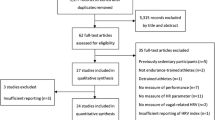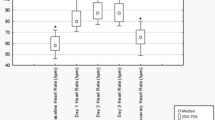Abstract
Purpose
Optimal autonomic regulation and stress resilience might be considered critical elements of athletic performance. We hypothesize that a novel unitary autonomic index for sports (ANSIs), together with a somatic stress related symptom score (4SQ) might help characterize athletes who were eventually selected for the Rio 2016 Olympic Games Italian team (Rio +).
Methods
In this retrospective study we examined 778 athletes (age 24.4 ± 6.7 yrs) who underwent a planned yearly pre-participation screening. All athletes underwent clinical, autonomic and exercise ECG evaluation. The combination of vagal and sympathetic indices from RR variability into ANSIs was performed by radar plot and percent ranking of index variables. We assessed (Rio +) versus (Rio −) athletes also after subdivision into three sport intensity groups (low, mid and high intensity).
Results
Overall there were no significant differences between (Rio +) and (Rio −) athletes when considering individual spectral derived variables. Conversely, the unitary Index ANSIs was significantly higher in (Rio +) compared to (Rio −) athletes (respectively 54.5 ± 29.5 and 47.9 ± 28.4 p = 0.014). This difference was particularly evident (p = 0.017) in the group of athletes characterized by both high static and dynamic components. 4SQ was smaller in the (Rio +) group, particularly in the groups of athletes characterized by both low-medium static and dynamic components.
Conclusions
ANSIs, a proxy of integrated cardiac autonomic regulation and simple assessment of resilience to stress, may differentiate Italian athletes who were eventually selected for participation in the 2016 Rio Olympic Games from those who were not, suggesting the possibility of a “winning functional phenotype”.

Similar content being viewed by others
Abbreviations
- 4SQ:
-
Somatic Stress Related Symptom Score
- a.m:
-
Morning
- A.U.:
-
Arbitrary units
- ANS:
-
Autonomic nervous system
- ANSI:
-
Unitary multivariate percent ranked ANS index
- ANSIs:
-
Unitary autonomic index for sports
- AR:
-
Autoregressive
- BMI:
-
Body mass index
- CM5:
-
ECG chest lead
- CONI:
-
Italian national olympic committee
- DC:
-
Deceleration capacity
- e.g.:
-
For example
- ECG:
-
Electrocardiogram
- HF:
-
High frequency
- HRV:
-
Heart rate variability
- J-T:
-
Jonckheere terpstra
- LF:
-
Low frequency
- nu:
-
Normalized units
- PC:
-
Personal computer
- RRV:
-
RR Interval variability
- SD:
-
Standard deviation
- SPSS:
-
Statistical package for the social sciences
- Δ:
-
Difference
References
Aubert AE, Seps B, Beckers F (2003) Heart rate variability in athletes. Sports Med 33:889–919
Badilini F, Pagani M, Porta A (2005) Heartscope: a software tool adressing autonomic nervous system regulation. Comput Cardiol 32:259–262
Bauer A, Kantelhardt JW, Barthel P, Schneider R, Makikallio T, Ulm K, Hnatkova K, Schomig A, Huikuri H, Bunde A, Malik M, Schmidt G (2006) Deceleration capacity of heart rate as a predictor of mortality after myocardial infarction: cohort study. Lancet 367:1674–1681
Buchheit M (2014) Monitoring training status with HR measures: do all roads lead to Rome?. Front Physiol 5
Chalencon S, Pichot V, Roche F, Lacour JR, Garet M, Connes P, Barthelemy JC, Busso T (2015) Modeling of performance and ANS activity for predicting future responses to training. Eur J Appl Physiol 115:589–596
Coote JH (2010) Recovery of heart rate following intense dynamic exercise. Exp Physiol 95:431–440
Coyle EF (1999) Physiological determinants of endurance exercise performance. J Sci Med Sport 2:181–189
D’Souza A, Bucchi A, Johnsen AB, Logantha SJ, Monfredi O, Yanni J, Prehar S, Hart G, Cartwright E, Wisloff U, Dobryznski H, DiFrancesco D, Morris GM, Boyett MR (2014) Exercise training reduces resting heart rate via downregulation of the funny channel HCN4. Nat Commun 5:3775
Ford I, Norrie J (2016) Pragmatic trials. N Engl J Med 375:454–463
Haken H (1983) Synergetics an introduction. Springer, Berlin
Hess WR. Nobel lecture: the central control of the activity of internal organs”.Nobelprize.org.Nobel Media AB 2014. Web. 29 Sep 2016. http://www.nobelprize.org/nobel_prizes/medicine/laureates/1949/hess-lecture.html
Iellamo F, Legramante JM, Massaro M, Raimondi G, Galante A (2000) Effects of a residential exercise training on baroreflex sensitivity and heart rate variability in patients with coronary artery disease: A randomized, controlled study. Circulation 102:2588–2592
Iellamo F, Legramante JM, Pigozzi F, Spataro A, Norbiato G, Lucini D, Pagani M (2002) Conversion from vagal to sympathetic predominance with strenuous training in high-performance world class athletes. Circulation 105:2719–2724
Iellamo D, Pigozzi F, Spataro A, Di S, Fagnani V, Roselli F, Rizzo A, Malacarne M, Pagani M, Lucini M D (2006) Autonomic and psychological adaptations in Olympic rowers. J Sports Med Phys Fitness 46:598–604
Imai K, Sato H, Hori M, Kusuoka H, Ozaki H, Yokoyama H, Takeda H, Inoue M, Kamada T (1994) Vagally mediated heart rate recovery after exercise is accelerated in athletes but blunted in patients with chronic heart failure. J Am Coll Cardiol 24:1529–1535
Katona PG, Jih F (1975) Respiratory sinus arrhythmia: noninvasive measure of parasympathetic cardiac control. JApplPhysiol 39:801–805
Kiviniemi AM, Tulppo MP, Hautala AJ, Vanninen E, Uusitalo AL (2014) Altered relationship between R-R interval and R-R interval variability in endurance athletes with overtraining syndrome. Scand J Med Sci Sports 24:e77-e85
La Rovere MT, Bigger JT Jr, Marcus FI, Mortara A, Schwartz PJ (1998) Baroreflex sensitivity and heart-rate variability in prediction of total cardiac mortality after myocardial infarction. ATRAMI (Autonomic Tone and Reflexes After Myocardial Infarction) Investigators. Lancet 351:478–484
Lazarus RS (2000) How emotions influence performance in competitive sports. Sport Psychol 14:229–252
Lorenz DS, Reiman MP, Lehecka BJ, Naylor A (2013) What performance characteristics determine elite versus nonelite athletes in the same sport? Sports Health 5:542–547
Lucini D, Milani RV, Costantino G, Lavie CJ, Porta A, Pagani M (2002) Effects of cardiac rehabilitation and exercise training on autonomic regulation in patients with coronary artery disease. AmHeart J 143:977–983
Lucini D, Di Fede G, Parati G, Pagani M (2005) Impact of chronic psychosocial stress on autonomic cardiovascular regulation in otherwise healthy subjects. Hypertension 46:1201–1206
Lucini D, Zuccotti GV, Scaramuzza A, Malacarne M, Gervasi F, Pagani M (2013) Exercise might improve cardiovascular autonomic regulation in adolescents with type 1 diabetes. Acta Diabetol 50:341–349
Lucini D, Solaro N, Pagani M (2014a) May autonomic indices from cardiovascular variability help identify hypertension? J Hypertens 32:363–373
Lucini D, Vigo C, Tosi F, Toninelli G, Badilini F, Pagani M (2014b) Assessing autonomic response to repeated bouts of exercise below and above respiratory threshold: insight from dynamic analysis of RR variability. Eur J Appl Physiol 114:1269–1279
Lucini D, Marchetti I, Spataro A, Malacarne M, Benzi M, Tamorri S, Sala R, Pagani M (2017) Heart rate variability to monitor performance in elite athletes: Criticalities and avoidable pitfalls. Int J Cardiol 240:307–312
Mahoney MJ, Gabriel TJ, Perkins TS (1987) Psychological skills and exceptional athletic performance. Sport Psychol 1:181–199
Manzi V, Castagna C, Padua E, Lombardo M, D’Ottavio S, Massaro M, Volterrani M, Iellamo F (2009) Dose-response relationship of autonomic nervous system responses to individualized training impulse in marathon runners. Am J Physiol Heart Circ Physiol 296:H1733–H1740
Mitchell JH, Haskell W, Snell P, Van Camp SP (2005) Task Force 8: classification of sports. J Am Coll Cardiol 45:1364–1367
Okano AH, Fontes EB, Montenegro RA, Farinatti PT, Cyrino ES, Li LM, Bikson M, Noakes TD (2015) Brain stimulation modulates the autonomic nervous system, rating of perceived exertion and performance during maximal exercise. BrJ Sports Med 49:1213–1218
Pagani M, Lucini D (2009) Can autonomic monitoring predict results in distance runners? Am.J.Physiol Heart Circ.Physiol 296:H1721–H1722
Pagani M, Lombardi F, Guzzetti S, Rimoldi O, Furlan R, Pizzinelli P, Sandrone G, Malfatto G, Dell’Orto S, Piccaluga E (1986) Power spectral analysis of heart rate and arterial pressure variabilities as a marker of sympatho-vagal interaction in man and conscious dog. CircRes 59:178–193
Pagani M, Somers V, Furlan R, Dell’Orto S, Conway J, Baselli G, Cerutti S, Sleight P, Malliani A (1988) Changes in autonomic regulation induced by physical training in mild hypertension. Hypertension 12:600–610
Pecanha T, Bartels R, Brito LC, Paula-Ribeiro M, Oliveira RS, Goldberger JJ (2017) Methods of assessment of the post-exercise cardiac autonomic recovery: A methodological review. Int J Cardiol 227:795–802
Plews DJ, Laursen PB, Stanley J, Kilding AE, Buchheit M (2013) Training adaptation and heart rate variability in elite endurance athletes: opening the door to effective monitoring. Sports Med 43:773–781
Saary MJ (2008) Radar plots: a useful way for presenting multivariate health care data. J Clin Epidemiol 61:311–317
Sala R, Spataro A, Malacarne M, Vigo C, Tamorri S, Benzi M, Lucini D (2016) Discriminating between two autonomic profiles related to posture in Olympic athletes. Eur J Appl Physiol 116:815–822
Sala R, Malacarne M, Solaro N, Pagani M, Lucini D (2017a) A composite autonomic index as unitary metric for heart rate variability: a proof of concept. Eur J Clin Invest 47:241–249
Sala R, Malacarne M, Tosi F, Benzi M, Solaro N, Tamorri S, Spataro A, Pagani M, Lucini D (2017b) May a unitary autonomic index help assess autonomic cardiac regulation in elite athletes? Preliminary observations on the national Italian Olympic committee team. J Sports Med.Phys.Fitness
Sassi R, Cerutti S, Lombardi F, Malik M, Huikuri HV, Peng CK, Schmidt G, Yamamoto Y (2015) Advances in heart rate variability signal analysis: joint position statement by the e-cardiology ESC Working Group and the European Heart Rhythm Association co-endorsed by the Asia Pacific Heart Rhythm Society. Europace 17:1341–1353
Schinke RJ, Battochio RC, Dube TV, Lidor R, Tenenbaum G, Lane AM (2012) Adaptation processes affecting performance in elite sport. J Clin Sport Psychol 6:180–195
Significance of differences between pairs of subgroups ((Rio +) vs (Rio -)) is indicated in the bottom left table
Smith ML, Hudson DL, Graitzer HM, Raven PB (1989) Exercise training bradycardia: the role of autonomic balance. Med Sci Sports Exerc 21:40–44
Task Force of the European Society of Cardiology and the North American Society of Pacing and Electrophysiology (1996) Heart-rate variability: standards of measurements, physiological interpretation and clinical use. Circulation 93: 1043–1065
Toninelli G, Vigo C, Vaglio M, Porta A, Lucini D, Badilini F, Pagani M (2012) DynaScope: a software tool for the analysis of heart rate variability during exercise. Comput Cardiol 39:181–184
White DW, Raven PB (2014) Autonomic neural control of heart rate during dynamic exercise: revisited. JPhysiol 592:2491–2500
Woodman T, Hardy L (2003) The relative impact of cognitive anxiety and self-confidence upon sport performance: a meta-analysis. J Sports Sci 21:443–457
Acknowledgements
We would like to thank Dana Alon Shiffer (LA, CA, USA) for mother tongue language and English style assistance.
Author information
Authors and Affiliations
Corresponding author
Ethics declarations
Conflict of interest
Authors declare that they have no conflict of interest.
Additional information
Communicated by Keith Phillip George.
Electronic supplementary material
Below is the link to the electronic supplementary material.
Rights and permissions
About this article
Cite this article
Lucini, D., Sala, R., Spataro, A. et al. Can the use of a single integrated unitary autonomic index provide early clues for eventual eligibility for olympic games?. Eur J Appl Physiol 118, 919–926 (2018). https://doi.org/10.1007/s00421-018-3822-2
Received:
Accepted:
Published:
Issue Date:
DOI: https://doi.org/10.1007/s00421-018-3822-2




